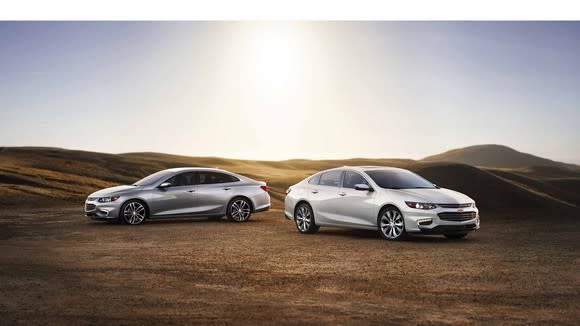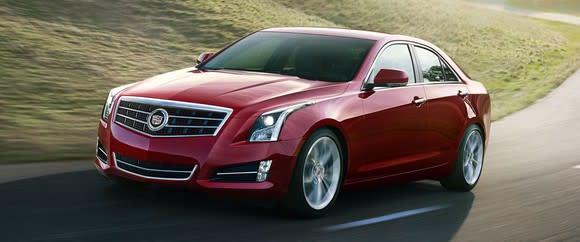Is GM Trying to Save the Chevy Malibu?
Last Monday, General Motors (NYSE: GM) announced that it will halt production at five of its manufacturing facilities in the U.S. and Canada next year. With passenger car sales slumping, GM plans to discontinue six models in North America: the Buick LaCrosse, Cadillac CT6. Cadillac XTS, Chevy Cruze, Chevy Impala, and Chevy Volt.
Yet unlike crosstown rival Ford Motor (NYSE: F), General Motors isn't planning to exit the traditional passenger car market entirely. Instead, by streamlining its car portfolio, GM may be hoping to shore up the viability of the remaining models, particularly the Chevy Malibu.

Image source: General Motors.
It could have been worse
GM has attracted plenty of criticism from elected officials across the political spectrum in both the U.S. and Canada for its cost-cutting plan. In addition to eliminating thousands of white-collar jobs through a combination of buyouts and layoffs, General Motors will lay off up to 6,700 factory workers as it idles five underutilized factories.
However, the bloodbath could have been far worse, as Reuters recently noted. Excluding the five factories that are on the chopping block, GM has another four U.S. car plants operating at less than 50% of capacity.
General Motors' Orion Township, Michigan facility has been running at just 34% of capacity. However, since it manufactures the Chevy Bolt EV -- the key to GM's big bet on creating the first autonomous-vehicle ridesharing service -- it is likely to get more work in the future.
Factories in Bowling Green, Kentucky, and Lansing, Michigan, are surviving for now because they make high-margin products. The former builds the Chevy Corvette sports car, while the latter covers Cadillac's two remaining sedans (the ATS and CTS) and the Chevy Camaro pony car.

The factory that builds the two smallest Cadillac sedans has survived for now. Image source: General Motors.
By contrast, the General's Fairfax Assembly plant in Kansas primarily builds the Chevy Malibu sedan. GM can't close it, because it just invested $265 million to bring production of the new Cadillac XT4 midsize crossover there. But the XT4 alone won't come close to fully utilizing the facility's capacity. Thus, General Motors has a strong incentive to keep the Chevy Malibu model alive as long as possible.
The Chevy Malibu is a solid entry
As my colleague John Rosevear described back in 2015, the current generation of the Chevy Malibu -- which debuted for the 2016 model year -- represented a huge step forward for the nameplate. In addition to providing better competition to the Japanese brands that dominate the U.S. passenger car market, the new Malibu leapfrogged the Ford Fusion, which hasn't been redesigned since the 2013 model year.
Customers responded well. In 2016, domestic deliveries of the Malibu jumped 17% to nearly 228,000 units. During the same year, market headwinds drove double-digit declines in the delivery totals for most of GM's other car models.
However, since then, plunging demand for sedans has caught up with the Chevy Malibu. U.S. deliveries fell 18% last year and plummeted another 24% through the first nine months of 2018.
One size fits many?
GM's management likely hopes that by discontinuing the Cruze and Impala nameplates in North America next year, it will have a better shot at saving the Chevy Malibu. After all, the Malibu slots in between the Cruze and Impala models in the Chevy lineup.
In the first nine months of 2018, combined domestic deliveries of the Cruze and Impala totaled 153,614 units, compared to 107,458 for the Chevy Malibu. Obviously, not everyone who would have opted for a Cruze or an Impala will buy Chevy's midsize car offering instead. Some will buy from other brands. Others will follow the market trend of upgrading to crossovers.
Nevertheless, there's a good chance that phasing out the Cruze and Impala will drive a return to growth for the Chevy Malibu in the second half of 2019 or 2020. Fleet buyers who have been purchasing the Cruze and Impala are likely to start buying more Chevy Malibu sedans. It should also help that Ford has already eliminated the Focus in North America and plans to stop building the Ford Taurus next March and the Fusion at some point thereafter (most likely in 2020).
It's unlikely that GM would invest in another all-new Malibu in the future, unless consumers' tastes shift dramatically back in favor of cars or the nameplate becomes a new electric vehicle platform. But the current model is fresh enough that it should be able to stay competitive for several more years without much additional investment. If GM's decision to kill off the Cruze and Impala models allows the current-generation Malibu to remain viable for another four years, it would be a big win for the company and its remaining domestic workforce.
More From The Motley Fool
Adam Levine-Weinberg owns shares of Ford and General Motors. The Motley Fool recommends Ford. The Motley Fool has a disclosure policy.

 Yahoo Finance
Yahoo Finance 